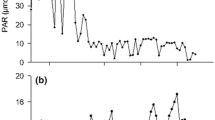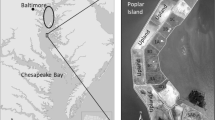Abstract
This study evaluates the effectiveness of community production and respiration measurements as monitoring tools for environmental impact evaluations and compares these data to community structural data.
In Prickly Pear Creek, Montana, production and respiration rates were determined for periphyton communities in control, impact and recovery reaches using colonized granite substrates and sealed plexiglas chambers. Values for gross primary productivity (GPP), community respiration (CR24), ash-free dry mass (AFDM) and chlorophyll a content (Chla) were obtained for each granite slab. Of these, AFDM, Chla and CR24 were statistically significant among sites (P≤0.01). Although mean values for GPP appeared to differ among reaches, statistical differences could not be inferred because of large variances associated with this measure. These data indicate that inherent variability may limit the use of community function measures in routine environmental monitoring. However, production/respiration methods provide valuable data about emergent properties of aquatic communities that cannot be derived from routine population censuses.
Similar content being viewed by others
References
Bates, J. M. & C. I. Weber (eds) 1981. Ecological assessments of effluent impacts on communities of indigenous aquatic organisms. ASTM STP 730. American Society for Testing and Materials, Philadelphia, PA.
Bott, T. L., J. T. Brock, C. E. Cushing, S. W. Gregory, D. King & R. C. Petersen, 1978. A comparison of methods for measuring primary productivity and community respiration in streams. Hydrobiologia 60: 3–12.
Bott, T. L., J. T. Brock, C. S. Dunn, R. J. Naiman, R. W. Ovink & R. C. Petersen, 1985. Benthic community metabolism in four temperate stream systems: an inter-biome comparison and test of the river continuum concept. Hydrobiologia 123: 3–45.
Brown, L. M., B. T. Hargrave & M. D. Mackinnon, 1981. Analysis of chlorophyll a in sediments by high-pressure liquid chromatography. Canadian Journal of Fisheries and Aquatic Sciences 38: 205–214.
Busch, D. E. & S. G. Fisher, 1981. Metabolism of a desert stream. Freshwater Biology 11: 301–307.
Clark, J. R., K. L. Dickson & J. Cairns, Jr, 1979. Estimating aufwuchs biomass. In R. L. Weitzel (ed.), Methods and Measurements of Periphyton Communities: A Review. ASTM STP 690. American Society for Testing and Materials, Philadelphia, PA: 116–141.
Giddings, J. M., P. J. Franco, R. M. Cushman, L. A. Hook, G. R. Southworth & A. J. Stewart, 1984. Effects of chronic exposure to coal-derived oil on freshwater ecosystems. II. Experimental ponds. Environmental Toxicology and Chemistry 3: 465–488.
Kimball, K. D. & S. A. Levin, 1985. Limiations of laboratory bioassays: the need for ecosystem-level testing. BioScience 35: 165–171.
Hansmann, E. W., C. B. Lane, & J. D. Hall, 1971. A direct method of measuring benthic primary production in streams. Limnology and Oceanography 16: 822–826.
La Point, T. W., S. M. Melancon, B. P. Baldigo, J. J. Janik & M. K. Morris, 1983. Investigation of Methods for Site Specific Water Quality Assessment: Prickly Pear Creek, Montana. EPA-600/X-83–051. U.S. Environmental Protection Agency, Environmental Monitoring and Systems Laboratory, Las Vegas, NV.
Maki, A. W. & H. E. Johnson, 1976. Evaluation of a toxicant on the metabolism of model stream communities. Journal of the Fisheries Research Board of Canada 33: 2740–2746.
Marker, A. F H., 1976. The benthic algae of some streams in southern England. II. The primary production of the epilithon in a small chalk-stream. Journal of Ecology 64: 359–373.
McIntire, C. D. & H. K. Phinney, 1965. Laboratory studies of periphyton production and community metabolism in lotic environments. Ecological Monographs 35: 237–258.
McIntire, C. D., R. L. Garrison, H. K. Phinney & C. E. Warren, 1964. Primary production in laboratory streams. Limnology and Oceanography 9: 92–102.
Miller, T. G., S. M. Melancon, T W. La Point, 1985. Use of effluent toxicity tests in predicting the effects of metals on receiving stream invertebrate communities. In H. L. Bergman, R. Kimerle and A. Maki (eds), Environmental Hazard Assessment of Effluents. Pergamon Press, Elmsford, NY.
Montana Water Quality Bureau, Department of Health and Environmental Sciences, 1981. Prickly Pear Creek: A report on man's debilitating impacts. WQB Report No. 81–2. Helena, MT.
Odum, H. T., 1956. Primary production in flowing waters. Limnology and Oceanography 1: 102–117.
Patrick, R., 1978. Effect of trace metals in the aquatic ecosystem. American Scientist 66: 185–191.
Rodgers, J. H., Jr., K. L. Dickson & J. Cairns, Jr., 1979. A review and analysis of some methods used to measure functional aspects of periphyton. In R. L. Weitzel (ed.), Methods and Measurements of Periphyton Communities: A Review. ASTM STP 690. American Society for Testing and Materials. Philadelphia, PA: 142–167.
Sheehan, 1984. Effects on community and ecosystem structure and dynamics. In P. J. Sheehan, D. R. Miller, G. C. Butler, P. Bourdeau and J. M. Ridgeway (eds), Effects of Pollutants at the Ecosystem Level. John Wiley & Sons, NY, pp. 51–99.
Sheehan, P. J. & R. W. Winner, 1984. Comparison of gradient studies in heavy-metal-polluted streams. In P. J. Sheehan, D. R. Miller, G. C. Butler, P. Bourdeau and J. M. Ridgeway (eds), Effects of Pollutants at the Ecosystem Level. John Wiley & Sons, NY, pp. 255–271.
Sokal, R. R. & F. J. Rohlf, 1981. Biometry, the Principles and Practice of Statistics in Biological Research, 2nd ed. W. H. Freeman and Company, San Francisco, CA.
Vannote, R. L., G. W. Minshall, K. W. Cummins, J. R. Sedell & C. E. Cushing, 1980. The river continuum concept. Canadian Journal of Fisheries and Aquatic Sciences 37: 130–137.
Vollenweider, R. A. (ed.), 1974. A Manual of Methods for Measuring Primary Production in Aquatic Environments, 2nd ed. Blackwell Scientific Publications, Oxford.
Warren, C. E., 1971. The Biology of Water Pollution Control. W. B. Saunders Co., Philadelphia, PA.
Weber, C. I., 1981. Evaluation of the effects of effluents on aquatic life in receiving waters — an overview. In J. M. Bates and C. I. Weber (eds), Ecological Assessment of Effluent Impacts on Communities of Indigenous Aquatic Organisms. ASTM STP 730. American Society for Testing and Materials, Philadelphia, PA.
Weber, C. I. & B. H. McFarland, 1981. Effects of exposure time, season, substrate type, and planktonic populations on the taxonomic composition of algal periphyton on artificial substrates in the Ohio and Little Miami Rivers, Ohio. In J. M. Bates and C. I. Weber (eds), Ecological Assessments of Effluent Impacts on Communities of Indigenous Aquatic Organisms. ASTM STP 730. American Society for Testing and Materials, Philadelphia, PA.
Westlake, D. F., 1980. Primary production. In E.D. LeCren and R. H. Lowe-McConnell (eds), The Functioning of Freshwater Ecosystems. IBP-22. Cambridge University Press, New York, NY.
Whitton, B. A. & P. J. Say, 1975. Heavy metals. In B. A. Whitton (ed.), River Ecology. University of California Press, Berkeley, CA.
Author information
Authors and Affiliations
Rights and permissions
About this article
Cite this article
Crossey, M.J., La Point, T.W. A comparison of periphyton community structural and functional responses to heavy metals. Hydrobiologia 162, 109–121 (1988). https://doi.org/10.1007/BF00014533
Received:
Revised:
Accepted:
Issue Date:
DOI: https://doi.org/10.1007/BF00014533




